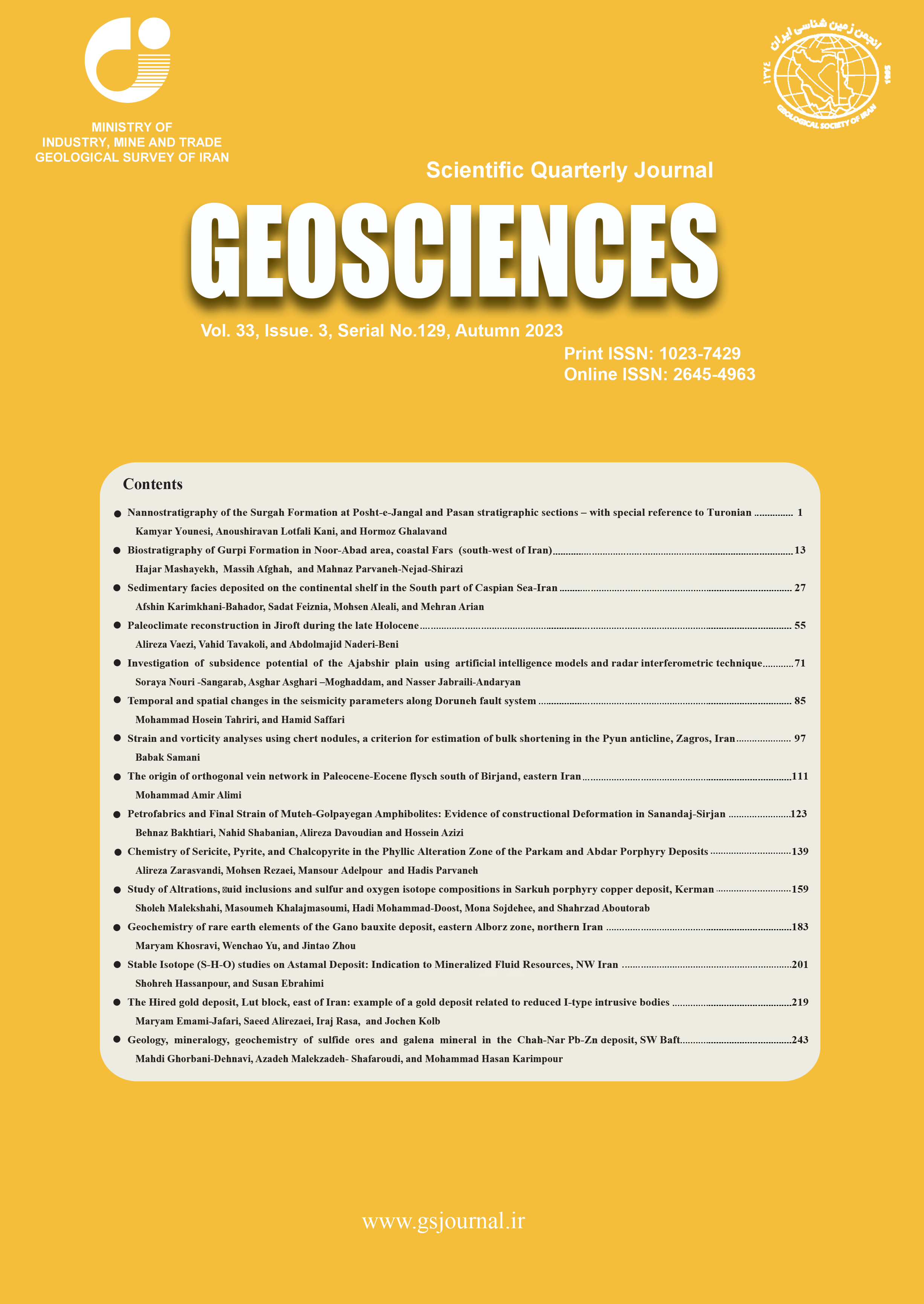Afghah, M., and Ghiyasi, A. A., 2013. Biostratigraphy of Gurpi Formation (Late Cretaceous) in Interior Fars: Bavan Area, Central Zagros (Southwestern Iran). J Earth Sci Climate Change 4:137. DOI:10.4172/2157-7617.1000137.
Asadi Mehmandosti, E., Adabi, M. H., Bowden, S. A., and Alizadeh, B., 2015. Geochemical investigation, oil–oil and oil–source rock correlation in the Dezful Embayment, Marun Oilfield, Zagros, Iran. Marine and Petroleum Geology, 68, 648-663.
https://doi.org/10.1016/j.marpetgeo.2015.01.018.
Asgharian rostami, M., 2013. Biostratigraphy and paleogeographic studies of Gurpi Formation in Mish khas section, south east of Ilam, based on foraminifera, geoscience journal, vol. 22, No.85. https://doi.org/10.22071/gsj.2012.54029. (In Persian).
Bolli, H. M., 1966. Zonation of Cretaceous to Pliocene marine sediments based on Planktonic foraminifera: Boletino Informative Associacion Venezolana de Geologica, Minerariay Petroleo v. 9, p. 3-32.
Bordenave, M. L., and Burwood, R., 1990. Source Rock Distribution and Maturation in the Zagros Belt; Provenance of the Asmari and Bangestan Reservoir Oil Accumulations. Organic Geochemistry, 16, 369-387. http://dx.doi.org/10.1016/0146-6380(90)90055-5.
Caron, M., 1985. Cretaceous planktic foraminifera; In: Bolli, H.M., Saunders, J.B., and Perch- Nielsen, K. (Editors). Plankton Stratigraphy; Cambridge University Press, Cambridge, 11-86.
Etemadi, M., Vaziri-Moghadam, H., Amiri Bakhtiyar, H., and Rahmani, A., 2009. Biostratigraphy and depth determining of sedimentary environment of Gurpi Formation in Lar (Gach mountain), based on planktonic foraminifera, Isfahan university research science journal, vol. 32, No.3. (In Persian).
Ghiami Esfahani, M., 2003. Biostratigraphy of Gurpi Formation in Sabz kuh (Borojen), based on planktonic foraminifera, Ms thesis of stratigraphy and paleontology, Isfahan university, p:74. (In Persian).
Hardenbol, J., Thierry, J., Farley, M. B., Jacquin, T., de Graciansky, P. C. and Vail, P., 1998. Mesozoic and Cenozoic Sequence Chronostratigraphic Framework of European Basins. In: Graciansky, P.C., et al., Eds., Mesozoic and Cenozoic Sequence Stratigraphy of European Basins, SEPM Special Publication 60, Tulsa, Charts 1-8, 3-13. https://doi.org/10.2110/pec.98.02.0003.
Lirer, F., 2000. A new technique for retrieving calcareous microfossils from lithified lime deposits; Micropaleontology 46:365–369.
Loeblich, A. R., and Tappan, H., 1988. Foraminiferal general and their classification", Van Nostrand Reinshold company, New York ,2 Volumes, 970p. plus 212p. DOI:org/10.1007/978-1-4899-5760-3.
Mahdavian rad, A., 2010. Lithostratigraphy and Biostratigraphy of Gurpi Formation in Kamestan anticline (north west of Izeh) and comprised with type section, north of Lali, Ms thesis, Shahid beheshti university, p:157. (In Persian).
Motiei, H., 1996. Geology of Iran (Zagros stratigraphy), Geological Survey of Iran, p: 583. (In Persian).
McQuillan, H., Roohi, M., and Evers, H. J., 1978. Cheshme Dozdan Geological map scale 1:100000. Tehran. National Iranian Oil Company.
Parvaneh -Nejad Shirazi, M., and Mirhoseini, F., 2019. Biostratigraphy and lithostratigraphy of Late Cretaceous–Early Palaeogene deposits in Tang e Abolhayat, Zagros basin (SW Iran), Carbonates and Evoporitesm 34(4).
DOI:10.1007/s13146-019-00522-2.
Petrizzo, M. R., 2003. Late Cretaceous planktonic foraminiferal bioevents in the Tethys and in the southern- ocean record: an overview; Journal of Foraminiferal Research 23, 330-337. DOI:
10.2113/0330330.
Premoli Silva, I. and Sliter, W. V., 1995. Cretaceous planktonic foraminiferal biostratigraphy and Evolutionary trends from the Bottaccione Section, Gubbio, Italy. Palaeontographica Italiana 82: 2-90 (another citation says 1994).
Premoli Silva, I., and Verga, D., 2004. Practical Manual of Cretaceous Planktonic Foraminifera, course 3, in Verga, D., and Rettori, R. (Editors), International School on Planktonic Foraminifera: Universities of Perugia and Milano, Tipografiadi di Pontefelcino, Perugia, Italy, 283 p. DOI:10.5923/j.ms.20140402.04.
Robaszynski, F., Caron, M., Gonza´lez Donoso, J. M., and Wonders, A.A.H., 1984. Atlas of Late Cretaceous globotruncanids. Revue de Micropale´ontologie 26, 145e305. DOI:
10.1016/j.cretres.2004.05.003.
Robaszynski, F., and Caron, M., 1995. Foraminiferes planctoniques du Cretace: Commentaire de la zonation Europe-Mediterrane. Bulletin de la Societe Geologique de France 166, 681-692.
DOI:10.1016/S0016-6995(99)80038-2.
Sigal, J., 1966. Contribution à une monographie des Rosalines. I. Le genre Ticinella Reichel, souche des Rotalipores. Eclogae Geologicae Helvetiae. 59: 185-217. DOI: 10.5169/seals-163365.
Sigal, J., 1977. Essai de zonation du Cretace Mediterraneenn a l aide des foraminiferes planctoniques. Geologie Mediterraneenne, 4, 99-108.
Sliter, W. V., 1989. Biostratigraphic zonation for cretaceous planktonic foraminifers examined in thin section. J Foraminifer Res 19:1–19.
DOI:10.2113/gsjfr.19.1.1.
Tulabian, N., 2012. Biostratigraphy of Gurpi Formation in Siah koh section (south west of Ilam), based on planktonic foraminifera, Ms. thesis of stratigraphy and paleontology, Shahid Beheshti uni, p.132. (In Persian).
Vaziri -Moghaddam, H., 2002. Biostratigraphic study of Ilam and Gurpi Formations based on planktonic. DOI:
10.1038/npre.2009.2947.1.
Vaziri -Moghadam, H., Kameli, A., Ghiami, M. and Taheri, A., 2007. Comparison of biostratigraphy Gurpi Formation in type section, north west of Masjed soleyman and Sabz kuh (south west Borojen), Kharazmi university science journal. (In Persian).

